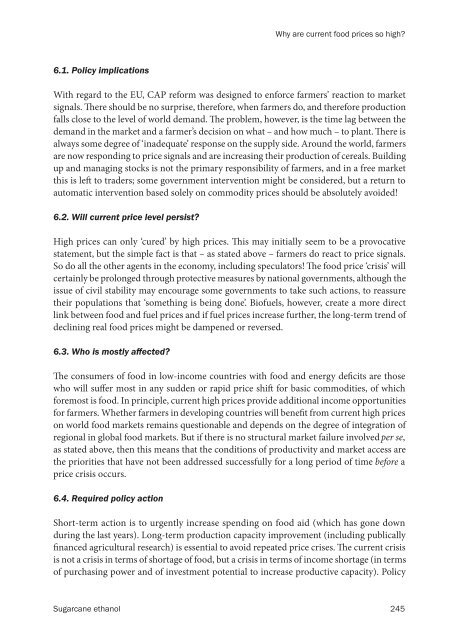Sugarcane ethanol: Contributions to climate change - BAFF
Sugarcane ethanol: Contributions to climate change - BAFF
Sugarcane ethanol: Contributions to climate change - BAFF
You also want an ePaper? Increase the reach of your titles
YUMPU automatically turns print PDFs into web optimized ePapers that Google loves.
6.1. Policy implications<br />
Why are current food prices so high?<br />
With regard <strong>to</strong> the EU, CAP reform was designed <strong>to</strong> enforce farmers’ reaction <strong>to</strong> market<br />
signals. �ere should be no surprise, therefore, when farmers do, and therefore production<br />
falls close <strong>to</strong> the level of world demand. �e problem, however, is the time lag between the<br />
demand in the market and a farmer’s decision on what – and how much – <strong>to</strong> plant. �ere is<br />
always some degree of ‘inadequate’ response on the supply side. Around the world, farmers<br />
are now responding <strong>to</strong> price signals and are increasing their production of cereals. Building<br />
up and managing s<strong>to</strong>cks is not the primary responsibility of farmers, and in a free market<br />
this is le� <strong>to</strong> traders; some government intervention might be considered, but a return <strong>to</strong><br />
au<strong>to</strong>matic intervention based solely on commodity prices should be absolutely avoided!<br />
6.2. Will current price level persist?<br />
High prices can only ‘cured’ by high prices. �is may initially seem <strong>to</strong> be a provocative<br />
statement, but the simple fact is that – as stated above – farmers do react <strong>to</strong> price signals.<br />
So do all the other agents in the economy, including specula<strong>to</strong>rs! �e food price ‘crisis’ will<br />
certainly be prolonged through protective measures by national governments, although the<br />
issue of civil stability may encourage some governments <strong>to</strong> take such actions, <strong>to</strong> reassure<br />
their populations that ‘something is being done’. Biofuels, however, create a more direct<br />
link between food and fuel prices and if fuel prices increase further, the long-term trend of<br />
declining real food prices might be dampened or reversed.<br />
6.3. Who is mostly affected?<br />
�e consumers of food in low-income countries with food and energy de�cits are those<br />
who will su�er most in any sudden or rapid price shi� for basic commodities, of which<br />
foremost is food. In principle, current high prices provide additional income opportunities<br />
for farmers. Whether farmers in developing countries will bene�t from current high prices<br />
on world food markets remains questionable and depends on the degree of integration of<br />
regional in global food markets. But if there is no structural market failure involved per se,<br />
as stated above, then this means that the conditions of productivity and market access are<br />
the priorities that have not been addressed successfully for a long period of time before a<br />
price crisis occurs.<br />
6.4. Required policy action<br />
Short-term action is <strong>to</strong> urgently increase spending on food aid (which has gone down<br />
during the last years). Long-term production capacity improvement (including publically<br />
�nanced agricultural research) is essential <strong>to</strong> avoid repeated price crises. �e current crisis<br />
is not a crisis in terms of shortage of food, but a crisis in terms of income shortage (in terms<br />
of purchasing power and of investment potential <strong>to</strong> increase productive capacity). Policy<br />
<strong>Sugarcane</strong> <strong>ethanol</strong> 245












